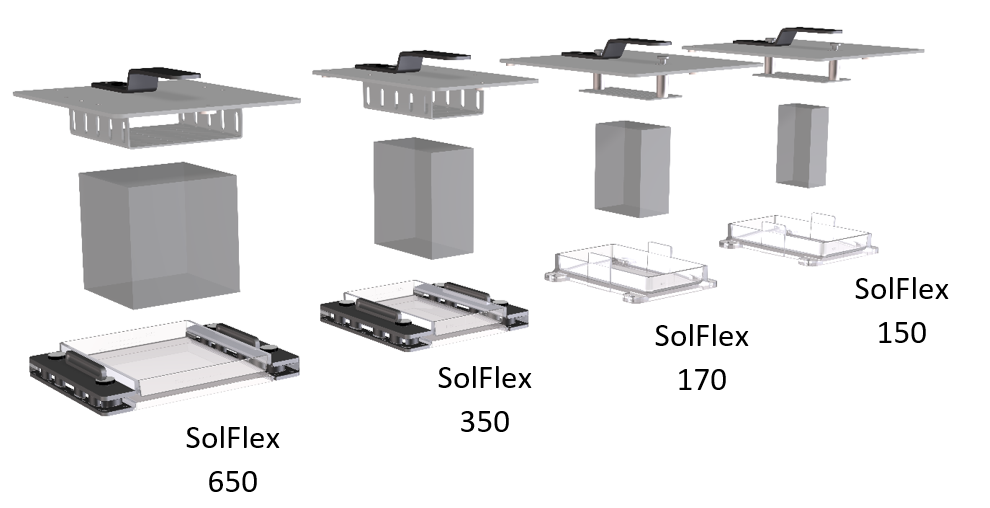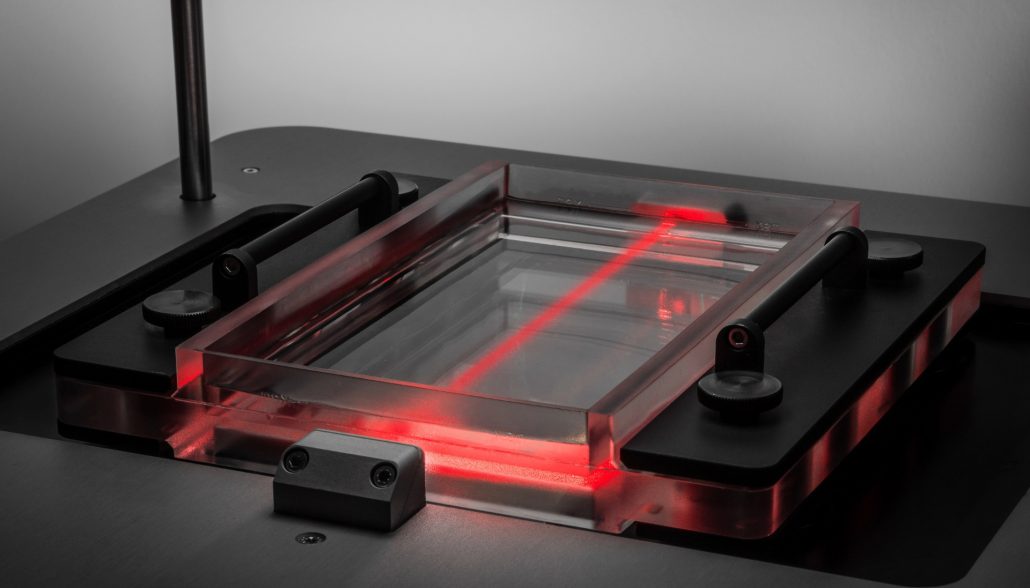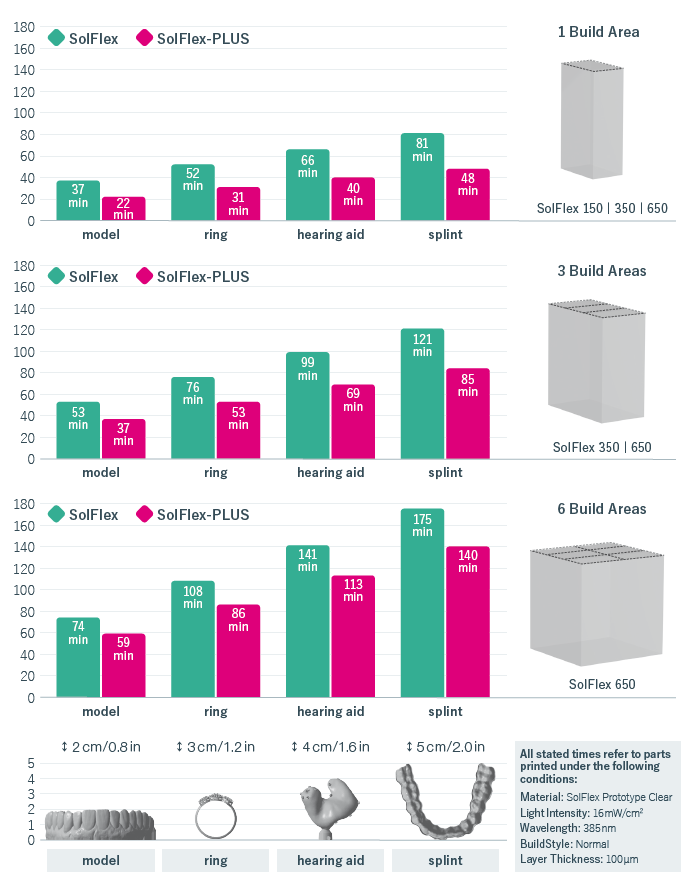FAQs
Frequently Asked Questions
Frequently Asked Questions
How do SolFlex 3D printers work?
SolFlex 3D printers make use of Digital Light Processing (DLP) which means that liquid light-sensitive photopolymers are converted into solid 3D objects through an UV light engine.
What are the print volumes of the SolFlex printers?

The SolFlex printers with a pixel size of 50 µm (650, 350 und 150) consist of build areas of 40 x 64 mm:
SolFlex 150: one build area
SolFlex 350: three build areas
SolFlex 650: six build areas

How does the Vat Deflection Feedback System (included in all PLUS models) work?
 The Vat Deflection Feedback System consists of a vat sensor which monitors and optimizes the printing process. Thus, printing results can be improved and printing times reduced.
The Vat Deflection Feedback System consists of a vat sensor which monitors and optimizes the printing process. Thus, printing results can be improved and printing times reduced.
What is the life span of the LED light source?
According to the manufacturer, the life span of the LED light source is 30,000 operation hours.
Do I need a PC in order to execute a print job?
Basically, the printer is a stand-alone-device and the job file – which is needed to start a print job – can be brought to the printer via a USB stick or a network port. The job file has to be generated in a software program (Netfabb).
How often do I have to initiate the printer?
The printer has to be initialized prior to every print job as well as every time you turn on the printer.
How do I clean the printer?
The printer has to be cleaned with Isopropanol using a (paper) tissue.
How do I clean the vat?
The material has to be removed from the vat, using a (paper) tissue with Isopropanol. The residues in the corners of the vat can be cleaned with cotton sticks or moistened with Isopropanol and cleaned air compression.
How do I store the vat?
The vat should be stored in an upright position or in the original packaging.
How many vats do I need?
In order to prevent contamination of clear material with colored material, it is recommended to use a separate vat for every material.
Can I reuse the handle sets for the vat?
Yes, the handle sets for the vats can be used for several vats.
How do I clean the building platform?
In order to move the building platform from the printer to the post processing area, hold a plastic box below the building platform. Do not turn around the building platform since it could lead to contaminations of the area in between the top of the building platform and the part carrier.
For the cleaning of the building platform, we recommend you to use Isopropanol and (paper) tissues. Strongly adhensive suppport structures can be removed with a silicone spatula.
In case you want to use another material for the next print, the building platform has to be cleaned very well. Therefore, the building platform can be disassembled or be put in an ultrasonic bath.
In case you use the same material for the next print, you do not need to clean the entire building platform, but please remove all hard residues from the platform.
What are the system requirements for Netfabb?
Netfabb requires a graphic card of at least OpenGL 3.3. The more complex the 3D models are, the more RAM and processor power is needed.
How do I place to objects perfectly?
If you do not use the whole building platform for your printed object(s), place the objects close to the edge of the platform since the peeling forces are lower in these areas than they are in the middle of the platform.
For smaller objects, please also mind the seaming line (= border of one build area). Printing within one build area saves printing times due to higher building speeds.
How do I place support structures?
When placing support structures, please follow these instructions:
> The parts of the printed object which are printed first, have to be connected to the building platform.
> The support structures have to be placed on the right positions. All overhanging parts with an angle of more than 45° to the building platform should be stabilized with support structures.
> There should be enough support structures to stand the peeling forces. The bigger the cross-sectional area of the object, the more support structures are needed.
> The connection between the support structures and the building platform should be enhanced by a base plate (hexagonal grid). The hexagonal grid should also cover the area surrounding the printed objects.
> The connection of the support structures to the printed objects should be stable enough to stand the peeling forces.
What should I do if an error message appears when opening Netfabb?
In case an error message in Netfabb appears, please try to restart the license service:
Start -> Insert services and open services -> scroll down -> right click menu -> „Sentinel LDK Licence Manager“ and „Restart“
After restarting, you should be able to start Netfabb again.
How long does one print job take?
The duration of one print job depends on the type and size of the printed object.
The following illustration shows example prints:
How do I know the estimated printing time?
The printer shows the estimated printing time. The estimation is based on the printing speed. Since the first 25-50 layers have lower building speeds, the estimation within the first 10 minutes seems very long. The actual printing time appears afterwards.
Is it possible to refill material during the printing process?
Yes, it is possible to refill material during a print job. Please pause the print, open the plastic cap and pour the material into the vat using a funnel.
How do I remove the printed parts from the building platform?
After the printing process, the printed parts can be levered off the building platform by means of a sharp object such as a spatula or tweezers.
Please note that the parts have to be handled with care to avoid damaging them.
Why are print jobs non-printable?
There are two very common reasons for non-printable print jobs:
1) The printer had not been initialized
2) The models were not well-prepared for printing in Netfabb and consequently, the first layers are missing or the grid is placed above the building platform. Thus, please double-check the first picture of the job files in Netfabb and make sure that there is a connection between the building platform and grid or the object you would like to print, respectively.
Why do objects dissolve themselves from the building platform?
To secure safe printing, you can use a wide-meshed grid and also, put a frame around the grind, leading to guarantee a more gentle separation of the printed parts from the building platform.
The printed parts should also be placed closed to the edges of the building platform and – if possible – not across the seaming line (= border of one build area).
Another reason why an object might dissolve from the building platform could be a big cross-sectional area. A way to reduce the cross-sectional area, move the parts to a more vertical position.
What kind of material do I need for my SolFlex printer?
3D printing by Digital Light Processing requires liquid resins (photopolymers).
The SolFlex 3D printers are open material systems which means that materials of various manufacturers can be used. Please note that the material you use works for devices within the UV spectrum (385 nm), as offered by Detax, NextDent or Dentona.
In case you would like to use materials which are not to be found in the material library of the SolFlex printer, please contact a support engineer first.
What should I consider prior to the use of the material?
Please read the instructions on the bottle as well as on the safety sheet carefully and follow all instructions. We also recommend you to shake the material bottle well (5 minutes) before using it. Model materials have to be shaken even more thoroughly, since they tend to be more sensitive to sedimentations.
Do I have to stir the material in between two print jobs?
Yes, the material has to be stirred in between two print jobs, using a soft object, such as a silicon scraper. Otherwise, particles could settle on the ground.
How should I store materials?
Keep the material in total darkness in order to avoid changes in color of the printed objects (yellowing).
How many objects can I print out of 1,000 g material?
Out of 1,000 g material, approx. 10% will be used for support structures, leaving 900 g for the actually printed parts. Please note that there are no exact rules for the use of support structures and therefore sometimes it might takes more than 10% of the used material to print them. Moreover, the amount of material depends on the kind of material and its viscosity.
The following examples are rough values to provide an orientation for the amounts of objects that can be printed with 1,000 g material.
Models (á 25g): 36 pcs.
Splints (á 7g): 128 pcs.
Ear moulds (á 4g): 225 pcs.
Rings (á 1g): 900 pcs.
Netfabb gives you the exact building volume of an object. Based on the building volume, the material use can be calculated.
How much material fits in the vat?
There are three different types of vats with different maximum capacities:
Vat for SolFlex 650: 250 g material
Vat for SolFlex 350: 175 g
Vat for SolFlex 150/170: 175 g material
The mark on the vat shows the maximum filling level and helps you to not overfill the vat.
The minimum amount of material that should be put in the vat depends on the material use for the printed object. It is recommended to use double of the required amount.
What kind of material does W2P recommend?
The full list of materials included in the material library, can be found in the material overview (see section „Material“ of the login area).
Do I have to remove the residual material after the printing process?
Yes, the material should be removed from the vat and kept in a safe, closed container in a dark environment.
How do I have to post process the printed objects?
After having removed the printed objects from the building platform, the following post processing actions have to be taken:
1) Cleaning
2) Removing support structures
3) Post-curing (if necessary; not all materials need to be post-cured)
Please wear appropriate safety equipment during the post processing phase, including a laboratory coat, safety goggles as well as single-use gloves.
How do I clean the printed objects?
The objects have to be cleaned twice. First, clean the objects directly after levering them off the building platform. Also, clean the objects a second time after having removed the support structures.
Cleaning instructions:
1) Place the printed parts in a container filled with Isopropanol
2) The container has to be cleaned in an ultrasonic bath as long as stated in the safety sheet of the material
3) The residual material has to be removed through air compression
How do I remove support structures?
Support structures should be removed carefully by using scissors. In case there are sharp ends, grind them in order to provide a smooth surface quality.
How do I post-cure the printed objects?
As recommended by most material manufacturers, the printed objects should be dried before post-curing them. For best results, please use the flash device recommended for the used material. Otherwise there might be changes in color of the material. The printed parts should be post-cured for the indicated time.
Can the parts be steam sterilized at 134°C?
The material properties can be found in the safety sheets of the material manufacturer. NextDent and Detax, for example, provide materials that can be steam sterilized.
How long does the post-curing process in the flash device take (Otoflash / LC 3D Printbox)?
The post-curing time depends on the material and ranges from 3 to 10 minutes.
Leading material manufacturers recommend the following post-curing times:
Detax Freeprint Splint UV: 2000 flashes with the Otoflash (2000 flashes take approx. 3 minutes)
Detax model materials, e.g. Detax Model Grey UV: 2 x 3000 flashes (6000 flashes take approx. 10 minutes)
NextDent: at least 10 minutes; longer post-curing times are recommended.
The default setting of the LC 3D Printbox is 20 minutes.
Why do Detax materials have to be cured with protective gas, whereas NextDent materials do not need protective gas?
Detax materials use oxygen for post-curing, meaning that oxygen surrounding the printed parts has to be displaced in order to ensure an optimal curing on the surface of the printed part.
Therefore, nitrogen is used to displace oxygen.
We have also used warm tab water, leading to similar results as nitrogen.
NextDent materials do not need protective gas for post-curing.
Would it be possible to post-cure materials of different manufacturers using only one flash device (Otoflash G171)?
By experience, we know that it is possible to use the Otoflash device for various materials. However, please choose appropriate post-curing times (e.g. 2-3x 3000 flashes for NextDent SG).
Which kind of gas can be used for the flash device (Otoflash G171)?
Typically, the Otoflash G171 is flooded with nitrogen.
Can broke flash bulbs of the Otoflash G171 be replaced?
Yes, there are spare bulb modules available for Otoflash G171.
Can the polymerization device (Otoflash G171) be used to post-cure other materials too?
Basically, the polymerization device can also be used for other materials, but there might be changes in color or impairment of the biocompatibility of the material.